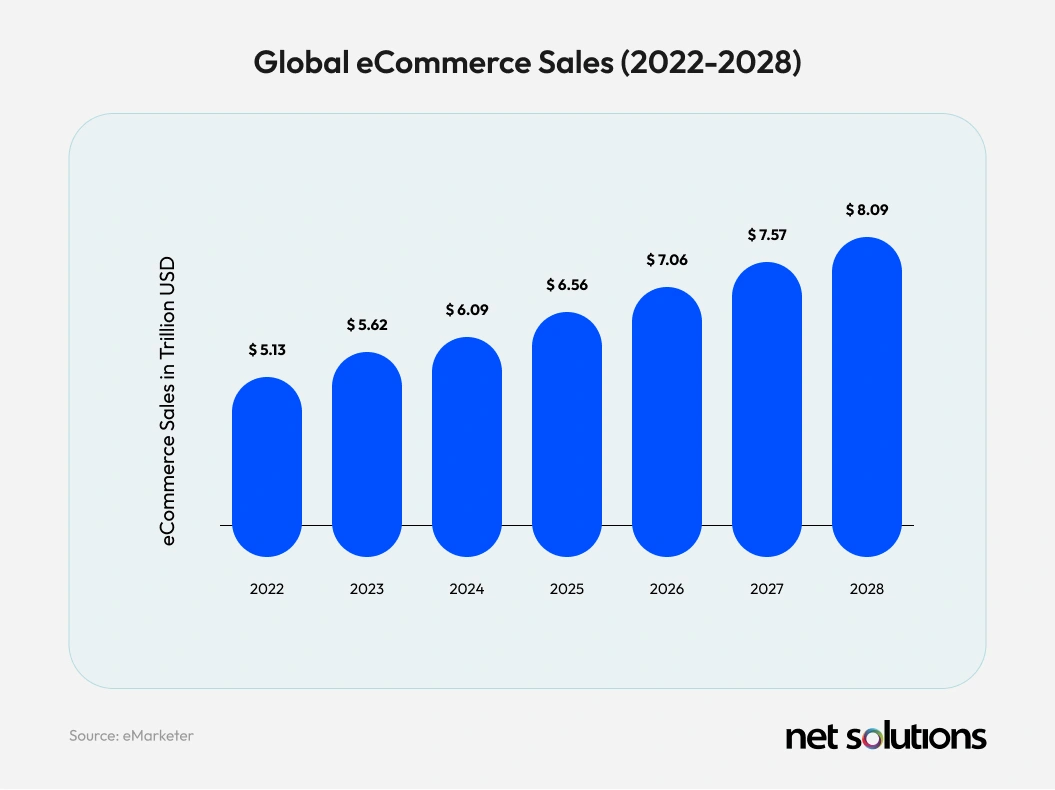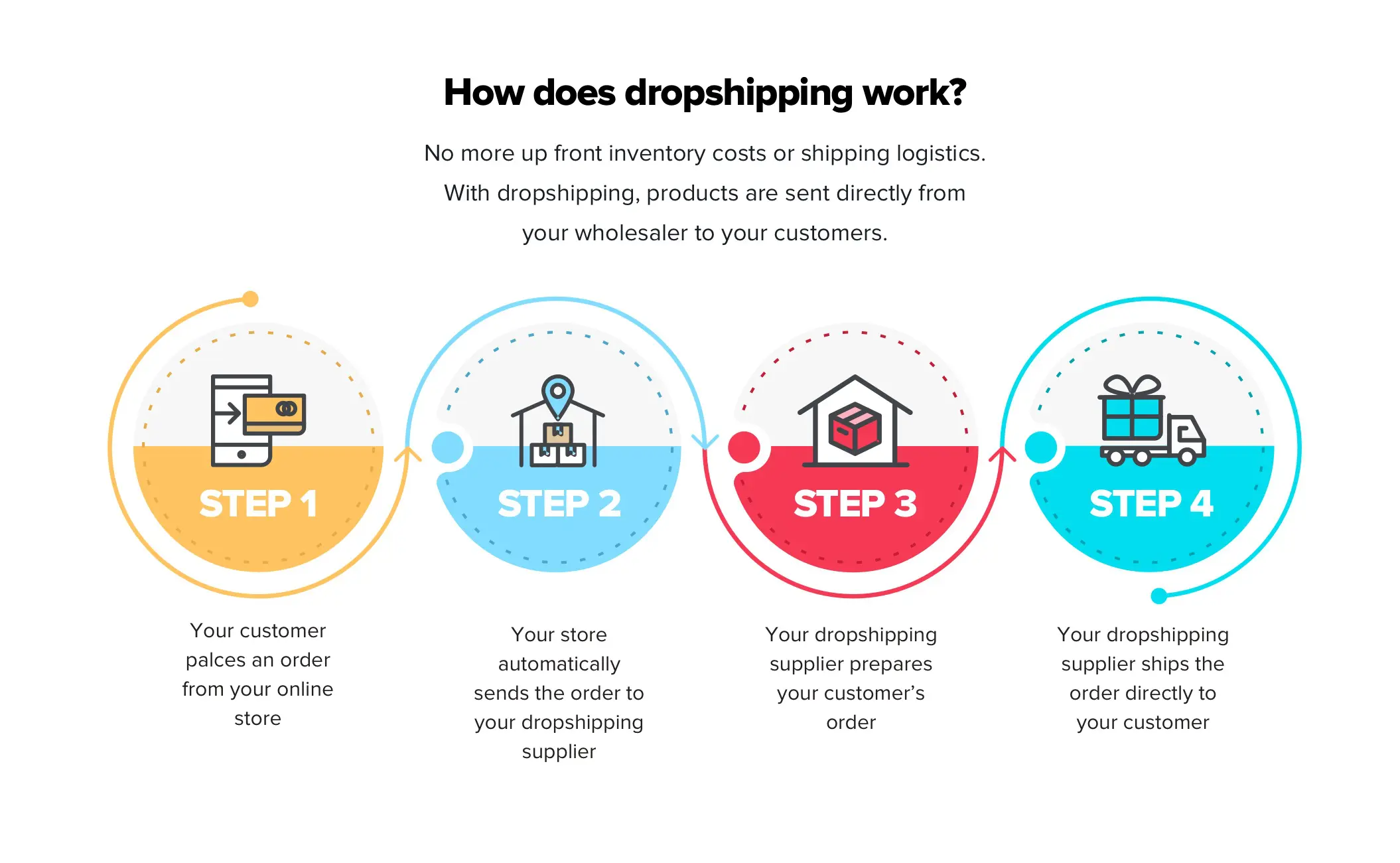Consumer behaviors and technologies continue to create greater expectations on what, how, when, and where consumers make their purchases. No longer do consumers simply want to shop for a product – they want to be delivered an experience and to make a purchase seamlessly anytime, anywhere.
According to Shopify, global retail e-commerce sales are expected to reach US$ 6.42 trillion in 2025. Ecommerce sales in 2026 are expected to make up 21.1% of total retail sales. By 2028, that number will grow to 22.5%.

COVID-19 has only accelerated these shifts in buying behavior and digital eCommerce trends, with an 169% increase in eCommerce purchases coming from new or previously infrequent users. The rapid shift in consumer behavior and subsequent digital transformation spurred by COVID-19 is estimated to accelerate the eCommerce industry by as much as five years.
Of course, with growth in the eCommerce marketplace comes greater competition. The low cost of entry to create a basic eCommerce site has greatly increased the volume of competition, while on the other hand brands are working against mega-retailers such as Amazon. All of this competition makes it more difficult and expensive to attract customers to your own eCommerce site.
To keep pace with changing consumer demands, brands must adopt eCommerce models that support flexibility and personalized experiences to ensure the customers they do attract are sticking around to make a purchase and remain loyal over time.
Popular eCommerce Business Models
Customers today have high expectations of their online shopping experience, from content to browsing, purchasing, and returning or exchanging. eCommerce as a framework spans everything from single-product sale pages to comprehensive omnichannel experiences, making it overwhelming to understand which model is right for you.
In this post, we’re going to explore three of the most popular eCommerce business models delivering the shopping experiences consumers now expect from retailers.
- The Traditional B2B/B2C Model When we think of eCommerce, the traditional retail model is still the most popular – the only difference is the transaction is conducted online rather than in a physical store. In the traditional model, businesses provide products and services to other businesses (B2B eCommerce) or consumers (B2C eCommerce). While we can further differentiate, traditional eCommerce B2B / B2C retailers manage their inventory, sales, and fulfillment.
Benefits
- Control – You have the ultimate control over every aspect of your business, from branding and technology to customer service, inventory, shipping, and promotions.
- Customer Experience – When you control every touchpoint with the consumer, you have greater opportunity and insight to improve the customer experience.
- Established Systems – As an established model, there are many eCommerce platforms and add-ons to support inventory management, sales, shipping, loyalty, and more.
Challenges
- Cost – Traditional retailing requires a significant up-front cost to purchase and manage inventory, in terms of product, space, as well as staff.
- Inventory Mismanagement – Buying your inventory up-front runs the risk that consumer demand will either not meet or will exceed your planning, leaving you with a stock of products you cannot sell or with unhappy customers.
- Reaction time – When you hold your own inventory or run a large online store, you may have difficulty with responsiveness.
- Customer expectations – Users now place the greatest demand on the B2C experience across every touchpoint, with users demanding a seamless omnichannel experience that can require significant investment.
- Online marketplaces – Large retailers and online marketplaces are getting harder to compete against, especially as they drive consumer shopping behavior. Despite the trend to “buy local” or “shop small,” 63% of consumers begin their shopping journey directly on Amazon.
The key to success in a traditional B2B / B2C eCommerce approach is to stay on the forefront of offering a personalized, interwoven customer experience across all touchpoints.
- Dropshipping Traditionally, retailers need to invest in inventory before they can begin selling. Dropshipping is a model where you sell products without ever keeping them in stock. In the dropshipping model, you leverage third-parties (“dropshippers”) to fulfill orders you collect as you collect them.

Benefits
- Low cost of entry and overhead – You do not carry or own stock or fulfill orders, making this the eCommerce model with the lowest capital requirements (cost of entry / overhead). Brands need only set up an eCommerce website and find dropshipping partners (databases, apps, word of mouth) to begin selling.
- Automated just-in-time ordering – Customer orders trigger an automated dropshipper order, taking all the guesswork out of ordering and inventory management. Orders are paid for by customers before you pay suppliers.
- Location independent – You can set up shop from anywhere in the world and ship to anywhere in the world, depending on your dropshipping agreements.
- Flexible – You are not committed to any particular inventory, allowing you greater flexibility to react to changes in customer demand and to carry a greater variety in products. Change your “stock” at any time!
- Scalable – By leveraging dropshipping suppliers, you offload the bulk of the work associated with increased orders. Having multiple suppliers for the same product can save on shipping costs (depending on fulfillment location) and support scalability.
Challenges
- Increased competition – Of course, what makes it easy for you to set up shop also makes it easier for others, including those who are willing to take the smallest of profit margin.
- No bulk pricing – When you are ordering just-in-time, you cannot take advantage of bulk pricing, resulting in a higher cost per item and lower margin.
- Inventory management – When you hold your own stock, you know exactly what you have to sell. Unless your eCommerce site integrates seamlessly with supplier inventory levels, you risk accepting orders you cannot fulfill.
- Customer service – When you rely on third parties for fulfillment, you lose control over one of the most important touch points with the customer. If the shipping, tracking, or return processes are not frictionless, as the “seller” you accept all blame for issues outside your control.
- Increased shipping costs – If you sell items through multiple dropshippers, you risk incurring multiple shipping costs that could be difficult to pass along to consumers. Careful planning and pricing are needed to avoid reducing your margins.
- Compliance – As the retailer, you assume the primary liability associated with data and privacy compliance. Regulations around consumer data can differ by US state, industry, and by country and require a heavy burden for the retailer and all third-parties (including dropshippers) who may have access to consumer data.
The key to success under dropshipping is having an effective eCommerce platform that connects dropshipper inventory in real-time to your retail storefront. The most successful dropshipping brands are looking to customer experience (CX) to improve sales and loyalty.
Private & White Label Dropshipping
Two variants of drop shipping are private label and white label marketing.
Under private labeling, a manufacturer creates a new product exclusively for the retailer. For private labeling, you often have to agree to minimum inventory and order volumes – while you do not hold the inventory or fulfill orders, you do have to pay for it up front.
White labeling is similar to private labeling, but without the exclusivity. In white labeling, an existing product will be made available to retailers under their own brands. While you cannot differentiate by product, effective marketing can allow you to increase the perceived value of your brand – and your profit margin.

Private and white labeling allow you to differentiate what you are offering to consumers, but it does so at added cost and risk.
- Subscription Model In the subscription model, a company sells its products or services on a recurring basis, either monthly, quarterly, or yearly. Subscription eCommerce has seen massive growth by taking advantage of convenience, in-built loyalty, and in the case of “loot boxes,” a sense of novelty. You can buy pretty much anything as a subscription these days, from razors and underwear to music and even groceries.
In B2C retailing, subscriptions typically fall under three types: replenishment (convenience), curation (surprise products), and access (VIP products).
Benefits
- Recurring revenue – Once a customer signs up for your subscription, they become a reliable source for revenue for as long as the products and services continue to delight and deliver on a sense of value.
- Larger sales per customer – Rather than a customer only buying one product, a subscription box often contains many products, increasing your customer lifetime value.
- Discount purchasing/marketing – The novelty of the model is enticing many smaller brands to offer discount pricing to be a part of a subscription box and the opportunity to reach more consumers.
Challenges
-
- High barrier to purchase – Unless the model focuses on replenishment, there is a high perceived risk to customers to sign up for a recurring subscription.
- New model – Current data shows that roughly 55% of consumers purchased at least one subscription box in the last year, but growth is now driven by social commerce. Over half of Gen Z consumers now discover and purchase new products directly through social media platforms like TikTok and Instagram.
- Cost – In order to deliver on perceived overall value, you must work to discount your purchase price on goods, to discount your own products, or to factor in the cost to package your boxes with a “premium” experience.
- Customer churn – Churn remains a major hurdle, but it is highly industry-specific A critical new finding is that 70% of subscribers would reconsider canceling if offered a “pause” feature or loyalty incentive, rather than a hard cancellation.
Retailers that succeed at subscription services can be rewarded with loyal long-term customers.
Which Model is Best for You?
When it comes to today’s digital commerce scenario, it’s not enough to be responsive: you’ve got to anticipate increasingly savvy shoppers’ needs, desires, expectations — and attention spans. At Net Solutions, we bring over two decades of eCommerce experience to help you decide which eCommerce is right for your goals and and create optimal ecommerce solutions. We excel in building formats related to:
- eCommerce strategy, design, set-up
- Multi-channel commerce
- Ready-made platforms and custom Integrated billing, payment consolidation & distribution
- Integrated billing, payment consolidation & distribution
- Time-based inventory management
- Dropshipping
- Loyalty management
Net Solutions creates award-winning digital experiences and eCommerce platforms that deliver on your brand promises. From UX experts to specialized eCommerce business analysts and technical architects, Net Solutions provides results-driven, 360° strategy that’s robust, scalable, secure – and always focused on surprising and delighting customers.
SHARE THIS POST
Table of Contents
Related Services
Related Resources
- eCommerce App Development Cost: Budgeting In-Depth Guide
- 13 Differences Between B2B and B2C eCommerce Websites
- Top 10 eCommerce Challenges and Easy Ways to Overcome Them
- eCommerce for Business: Is eCommerce Applicable for All Business Types
- eCommerce Customer Journey Mapping - The Secret to Higher Conversion Rates
- What is Headless Commerce? The Ultimate Guide
- Top 15 eCommerce KPIs to Track the Performance of Your Online Business
- Why Your Business Needs a Mobile eCommerce App
- Omnichannel Retail Strategy: A Comprehensive Guide
- Omnichannel vs Multichannel Retailing: The Complete Guide
- What is eCommerce Order Fulfilment? (And 6 Steps to Improve the Process)
- PCI Compliance: Everything You Need To Know
- The BEST Guide to eCommerce Personalization
- 12 Essential Factors for Choosing the Best eCommerce Platform
- The Ultimate Guide to Product Information Management (PIM) Systems for Ecommerce
- What is a Product Recommendation Engine (And How it Helps Boost Sales)
- eCommerce Replatforming: Challenges, Benefits, and Best Practices
- The Ultimate Guide to eCommerce Security
- Top 13 eCommerce Trends in 2025
- How Voice Search will Transform the Future of eCommerce
- What is Web Accessibility (And Why it Matters for Your eCommerce Business)


